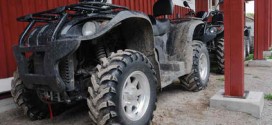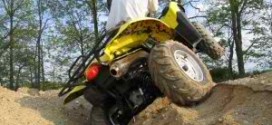 Selecting a new set of tires for your ATV shouldn’t be a difficult experience. If you know what to look for, you can get the perfect set of tires for your quad without emptying your pocketbook. There are five things you should be aware of and look for when selecting a tire, or set of tires, for your ATV. Selecting the wrong tires can decrease performance, kill your fuel economy, and possibly damage your ATV. Follow our guidelines below, and you should be able to select the best possible tire for your ATV every time.
Selecting a new set of tires for your ATV shouldn’t be a difficult experience. If you know what to look for, you can get the perfect set of tires for your quad without emptying your pocketbook. There are five things you should be aware of and look for when selecting a tire, or set of tires, for your ATV. Selecting the wrong tires can decrease performance, kill your fuel economy, and possibly damage your ATV. Follow our guidelines below, and you should be able to select the best possible tire for your ATV every time.
1) Tread Pattern
The type of terrain you traverse most often should be one of the primary determining factors for the type of tire you select. There are basically four different types of tread patterns for ATV’s:
 a. Mud Tires – Characterized by their inside-to-outside, angled tread pattern, mud tires are directional tires that are designed to work primarily in, you guessed it – mud. Mud tires do work well, however, on other types of terrain (except hard-packed trails). If I had to buy only one set of tires, I would buy medium-aggressive mud terrain tires. Mud tires typically have very tall (nearly an inch, sometimes more) tread patterns with large voids between them. The concept behind this type of tread pattern is that they are, for the most part, self-cleaning. As the tire spins through the mud, the mud is forced from the center section of the tread pattern and pushed outward to the sides. The faster you spin the tires, the better this function works.
a. Mud Tires – Characterized by their inside-to-outside, angled tread pattern, mud tires are directional tires that are designed to work primarily in, you guessed it – mud. Mud tires do work well, however, on other types of terrain (except hard-packed trails). If I had to buy only one set of tires, I would buy medium-aggressive mud terrain tires. Mud tires typically have very tall (nearly an inch, sometimes more) tread patterns with large voids between them. The concept behind this type of tread pattern is that they are, for the most part, self-cleaning. As the tire spins through the mud, the mud is forced from the center section of the tread pattern and pushed outward to the sides. The faster you spin the tires, the better this function works.
There are three primary flaws to mud tires.
1) The tread life on mud tires is greatly diminished if you drive anywhere but mud (especially on hard-pack trails, or on concrete/asphalt.).
2) Because of the aggressive tread pattern, they offer less-than-optimal ride quality as compared to O.E. or trail tires.
3) Mud tires, again, due to their directional, median-type tread pattern, typically offer very little lateral stability when the ATV is side-hilling an obstacle.  b. Trail Tires – Trail tires, also known as “All-Terrain” tires, are tire manufacturers’ best attempt to create a tire able to handle a variety of terrain. Trail tires, while they do not excel at any one terrain, do offer a good range of traction in various terrains. An aggressive trail terrain tire would be my second choice, if I only had to buy one set of tires.
b. Trail Tires – Trail tires, also known as “All-Terrain” tires, are tire manufacturers’ best attempt to create a tire able to handle a variety of terrain. Trail tires, while they do not excel at any one terrain, do offer a good range of traction in various terrains. An aggressive trail terrain tire would be my second choice, if I only had to buy one set of tires.
The tread pattern on all-terrain tires vary tremendously, especially in the ATV industry. The tread on these tires range from approximately ½” to ¾” deep, and typically have overlapping tread patterns with smaller gaps between the tread lugs than mud terrain tires. However, if you are purchasing a set of all-terrain tires in order to see various types of terrain, you should look for a set that offers a good amount of self-cleaning capability.
All-terrain tires typically offer better lateral and vertical stability than most other tires, and will provide longer tire tread life than mud tires. The bottom line is, if you spend most of your time trail riding, seeing some mud, some sand, and some rocks, all-terrain tires are probably your best bet.

c. Sand Tires – These tires are characterized by their “paddle” or “scoop” type treads. The front tires typically have only one tread pattern: a raised rib, running down the center of the tire. This is the only tread pattern that provides good traction in the sand. All others fall short in this type of terrain. Furthermore, because these tires are so specialized, running your quad in the dunes with tires other than sand tires can overheat your ATV’s engine quickly.
Sand tires only have one purpose, and that’s sand. Don’t attempt to take sand tires on the trails, in the mud or on the street. They provide very little lateral stability in terrain other than sand, and they’ll fall apart (wear out, chunks will come off the paddles, etc.) on any terrain other than sand.
Sand tires are so specialized, that if your ATV sees sand dunes more than a couple times per year, you should consider purchasing a set of them for those runs.
 d. Racing Tires – Racing tires, like sand tires, are specialty-built, and are primarily designed for medium- to hard-packed trails and courses. They are also characterized by their flat-top, knobby construction, and are designed for high-speed runs.
d. Racing Tires – Racing tires, like sand tires, are specialty-built, and are primarily designed for medium- to hard-packed trails and courses. They are also characterized by their flat-top, knobby construction, and are designed for high-speed runs.
What’s the bottom line on tread design? For the ATV that sees a variety of terrains, an aggressive all-terrain tire will usually work best. If money is no object, the rider can purchase two or three sets of tires to serve varying purposes.
2) Price
For most of us, price will be a big factor in determining the type of tire you purchase for your ATV. The price of a single tire can range from $30 for a budget tire, to more than $150 for a specialized tire. On average, you can expect to spend about $150 to $200 for a set of quality tires for your ATV.
What’s the bottom line on price? Determine how much you can spend before choosing the brand of tire. There are more than a hundred brands, sizes, and types to choose from, and they vary widely in price. Set aside the amount of money you can afford, and then use the remainder of this guide to find a tire that suits your need.
3) Tire size (Width, Height, Sidewall Height)
We recommend that you replace your ATV’s tires with tires of equal, or as close to equal, width and height. Manufacturers spend a lot of time and money researching a tire’s size to match the gearing, engine power, handling and component-fit before the ATV heads out of the plant to the retailer. Here are some examples of pros and cons of changing tire size:
a. Smaller diameter tire – this will decrease the overall speed and increase the engine RPM. It will also increase hole-shot speed, but will decrease top-end speed. Riding on too small of a tire can stress a number of the components on your ATV, (e.g. engine, transmission, axles, etc.) because of the increased RPM of the tire. Smaller diameter tires will provide a firmer, yet less flexible ride. b. Larger diameter tire – this will increase overall speed and decrease engine RPM. It will also decrease your hole-shot speed, but will increase top-end speed. Installing too large of a tire however, can stress a number of the components on your ATV (e.g. engine, transmission, axles, etc.) because of the additional rolling mass, and the decreased RPM of the tire. Further, too large of a tire can overheat your ATV’s engine, because it has to work that much harder to turn a larger, heavier tire. Larger diameter tires will provide a softer, more flexible ride. Lastly, because of the extra rolling mass, your ATV’s breaking efficiency will be diminished.
c. Wider tire – this will increase the amount of tread pattern on the ground, thereby increasing traction, particularly laterally. Conversely, too wide of a tire, like too tall of a tire, will increase the amount of rolling mass and diminish braking ability and stress the drivetrain. Further, selecting a tire too wide can cause problems with the steering and suspension components of your ATV. Simply put, too wide of a tire can cause the suspension to come in contact with parts of your ATV it shouldn’t.
d. Narrow tire – this will decrease the amount of tread pattern contacting the ground, which is most cases is not a good thing. Some argue, however, that narrow tires-particularly mud tires- are more effective than wide tires. This debate has raged on for years, and the arguments are: Narrow tires will sink through the mud and contact terra firma below. Wide tires will float and skip across the soft goo. This editor prefers wider mud-terrain tires.
e. Sidewall Height – Until recently, most ATV’s have had tires with very tall sidewalls (made for small diameter rims). Tire manufacturers like ITP and Maxxis have recently started producing tires that will accept rims up to 12″ and 14″ in height. Like tire diameter and width, sidewall height has its pros and cons too.
A short sidewall tire of the same overall tire height means that the rims size is also taller. This means greater ground clearance, especially if you’re running your tires at a decreased pressure (for greater traction). Further, a shorter sidewall will produce less flex than a taller one, which can be good or bad, depending upon the type of off-roading you’ll be doing.
A taller sidewall tire will produce far more flex than a shorter one. Good for technical off-roading, but bad for high-speed, hard-packed course runs. Further, a taller sidewall is also more susceptible to punctures than a shorter sidewall.
What’s the bottom line on selecting tire size? We highly recommend that you select a tire as close as possible to the original equipment size. If you determine that you do want to change the size (width and/or height), try and strike a balance as best as possible, to reduce the risk of over stressing your ATV’s drive train and suspension components.
4) Flat or Round
This is an aspect of tire selection often over-looked by the novice tire purchaser. Take a look at your quad’s tires; go ahead, we’ll wait. Nearly every utility quad comes with round-top tires, while most sport quads come with flat-top tires.
A flat-top tire will put more tread to the ground, and is typically designed for medium- to hard-packed trails or courses. It will allow the rider to conduct “power slides” in a more controlled environment. This type of tire also provide superior sidewall stability.
In contrast, a round-top tire will typically roll under itself during hard cornering episodes, especially on hard-packed trails. A round-top tire is designed for more versatility. Unlike their flat-top brethren, a round-top will perform much better in soft, gooey environments. Finally, a round-top tire, for the most part, provides a softer ride.
What’s the bottom line in choosing a flat or round tire? A good rule of thumb is that utility and four-wheel drive ATV’s will typically benefit more from a round-top tire, while sport quads will benefit more from a flat-top tire.
5) Tire Construction (Ply Rating & Radial or Bias Ply)
This is an area that gets confusing, and is all to often overlooked when purchasing a set of tires. All tires are constructed of a special combination of polymers. Each manufacturer typically uses a secret ratio for their product. What you should look at are the ply rating and the belt type construction, as each aspect has an affect on the tire’s pliability, stability and handling characteristics.
a. Ply Rating – Years ago, (many years ago), a tire’s construction was rated by the number of plies within the carcass. This rating system was used when less durable material, (such as traditional rubber) was used to create the tire carcass. Because the material was less durable, it took more layers of bonded, fused material to increase the tire’s strength and longevity. However, with the advent of new technologies and materials, a tire can be constructed with only a few (2 or 3) plies of material, yet have the same strength and longevity of a 6- or 7-ply tire. Hence, a new tire may have a 6-ply rating (based on the old standards), yet be constructed with only a couple of layers. b. Radial vs. Bias Ply – Until recently, the vast majority of ATV tires were all bias ply. Bias ply tires are constructed utilizing plies or belts (typically rubber-coated plies composed of textile cords, usually nylon) that run diagonally (usually 30 degrees) from one bead to the other. One ply is set on a bias in one direction, and succeeding plies are set alternately in opposing directions crossing each other. Bias-ply tires are typically less flexible than radials, but are typically tougher in construction than their radial brothers.
Radial tires are fairly recent entries in the ATV market, and are tires that are constructed in two parts. First, a single layer of rubber-coated steel cables arch from one bead to the other to form the tire casing. Second, numerous rubber-coated steel belts are placed in the crown, under the tread, to form a strong stabilizing unit. Radial construction makes the tire more flexible, which reduces rolling resistance and improves fuel economy.
What’s the bottom line in selecting tire construction? Try and strike a good balance of ply ratings for your tire. Too great of a rating can, but not always, mean a stiffer, less pliable carcass. Too weak of a rating can, but not always, mean too soft of a carcass, and can also mean a weaker tire, one more susceptible to punctures. The jury is still out about the radial vs. bias ply tire construction. For now, we’ll stick with the tried and true bias ply until we get some more experience with radial ATV tires.
Where to buy
This may be yet another factor in purchasing a tire, but should not determine the type of tire your purchase. Tires can be purchased at dealerships or retail outlets, as well as on the web. Typically you’ll find that the prices of tires are exceedingly higher at dealerships, lower at retail outlets, and somewhere in between on the web. Don’t be duped by the low advertised price for tires on the internet though. Shipping costs typically overshadow the perceived money saved on their lower rates.
 4x4Review Off Road Magazine
4x4Review Off Road Magazine



